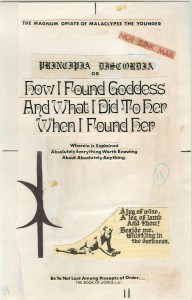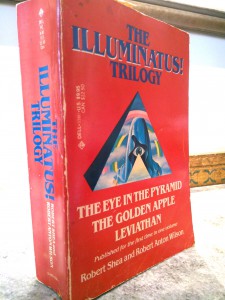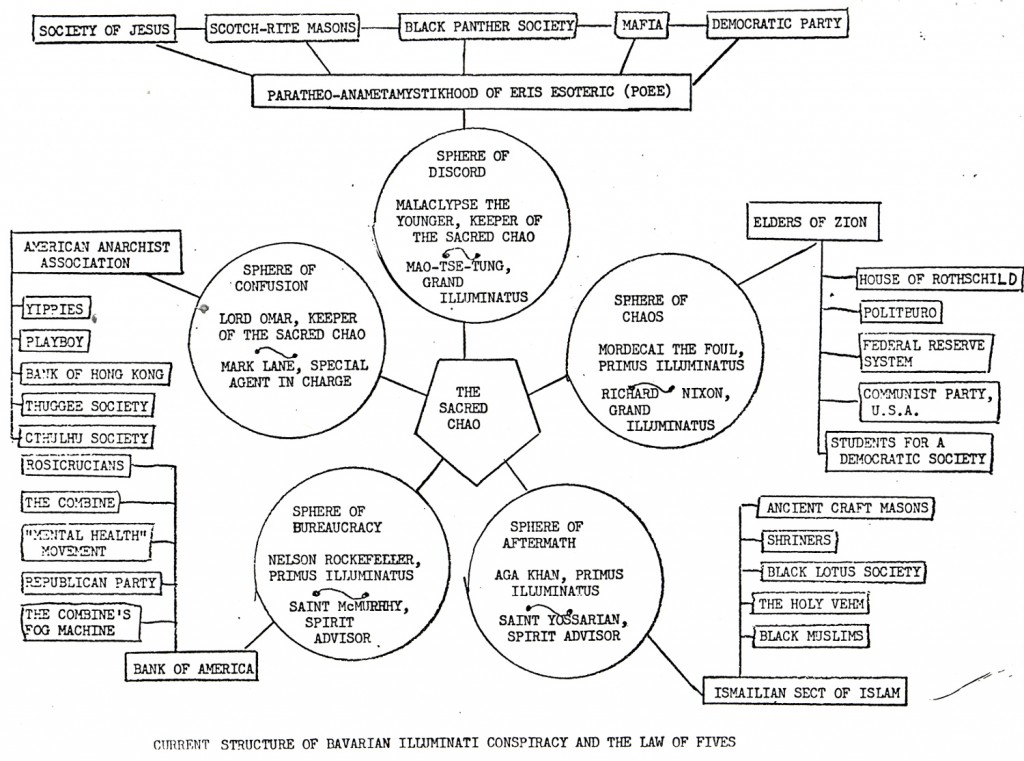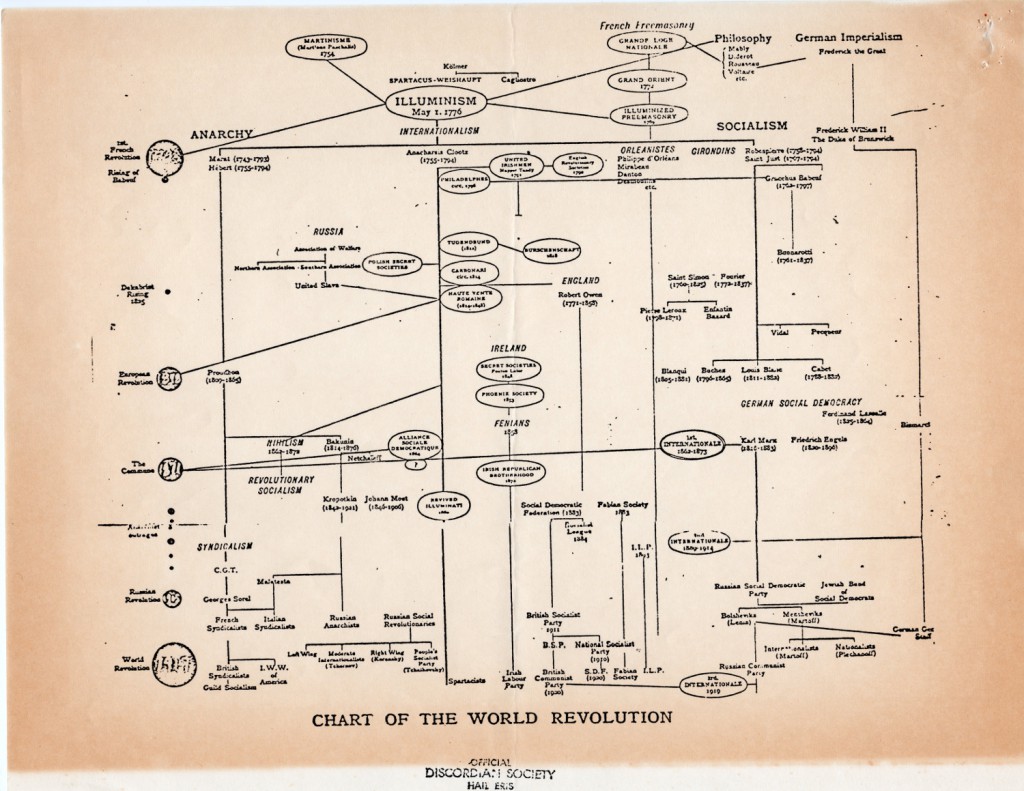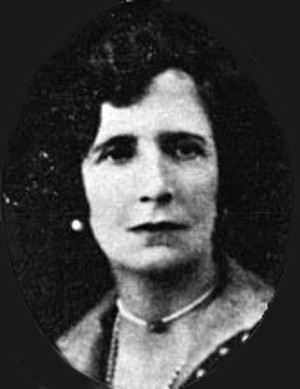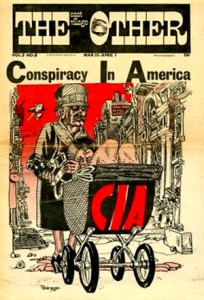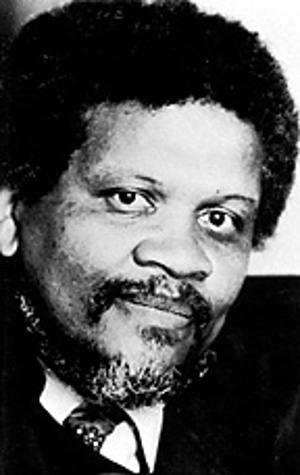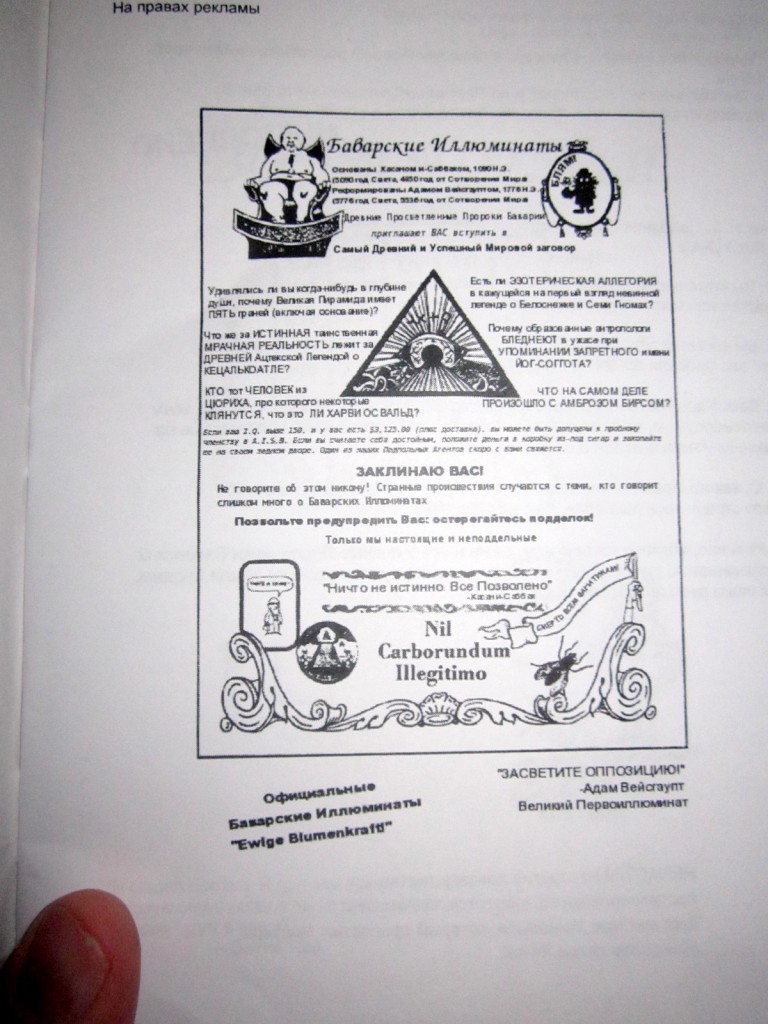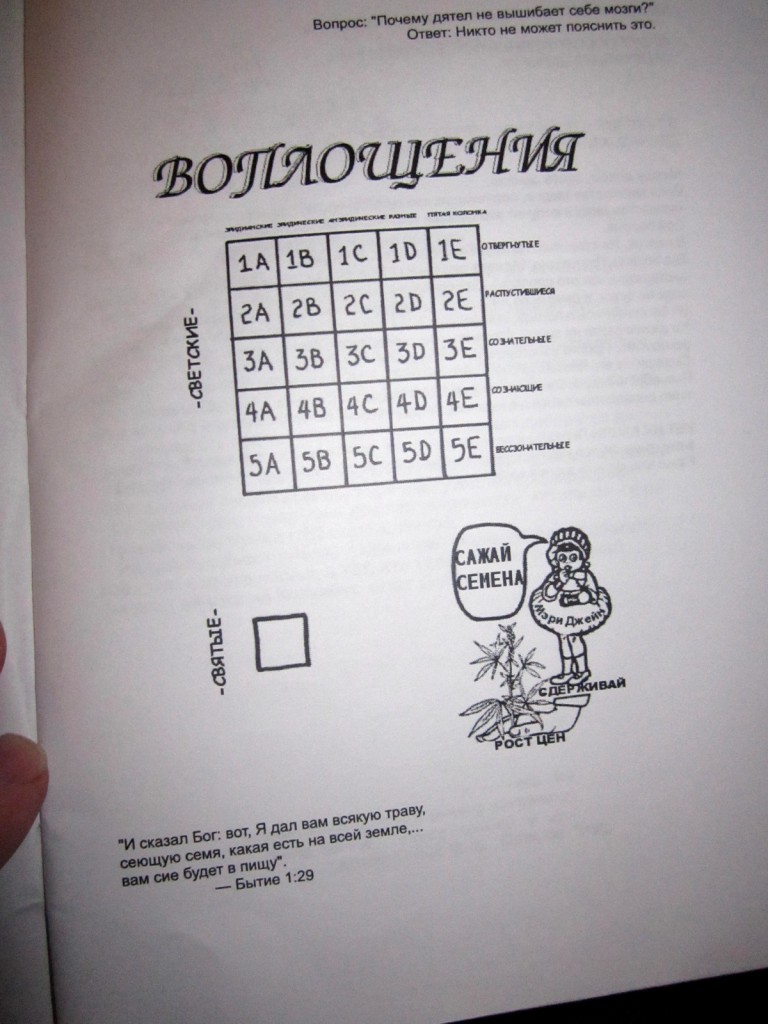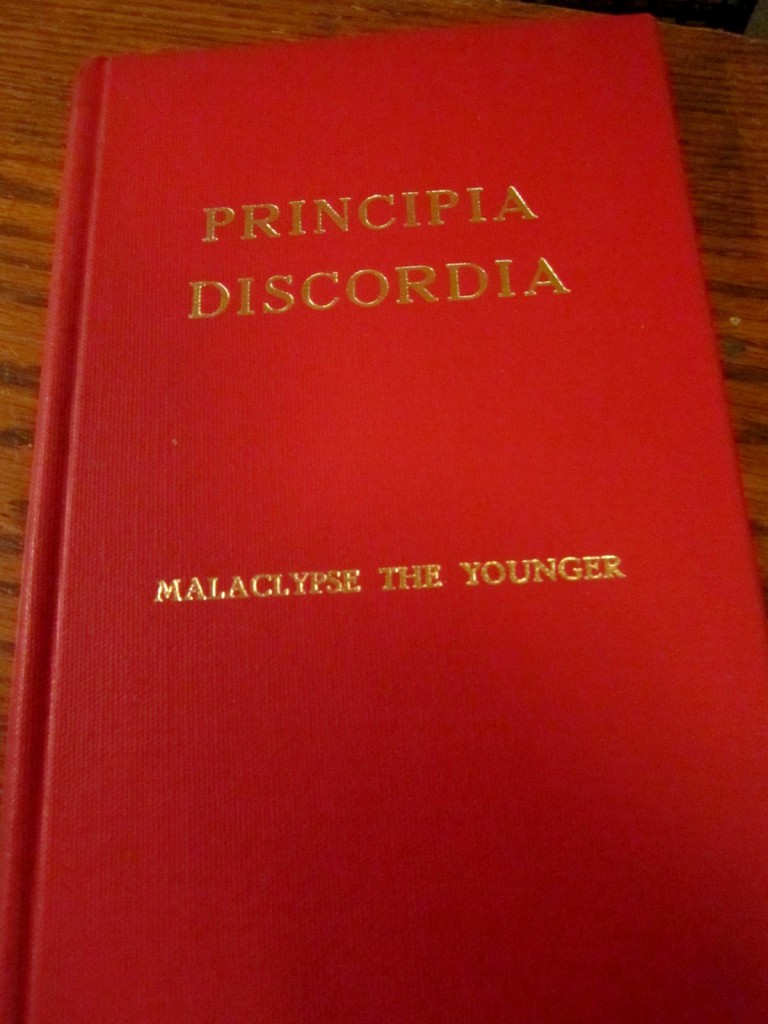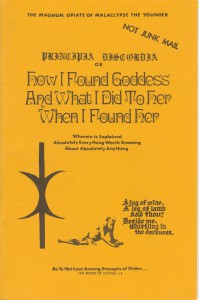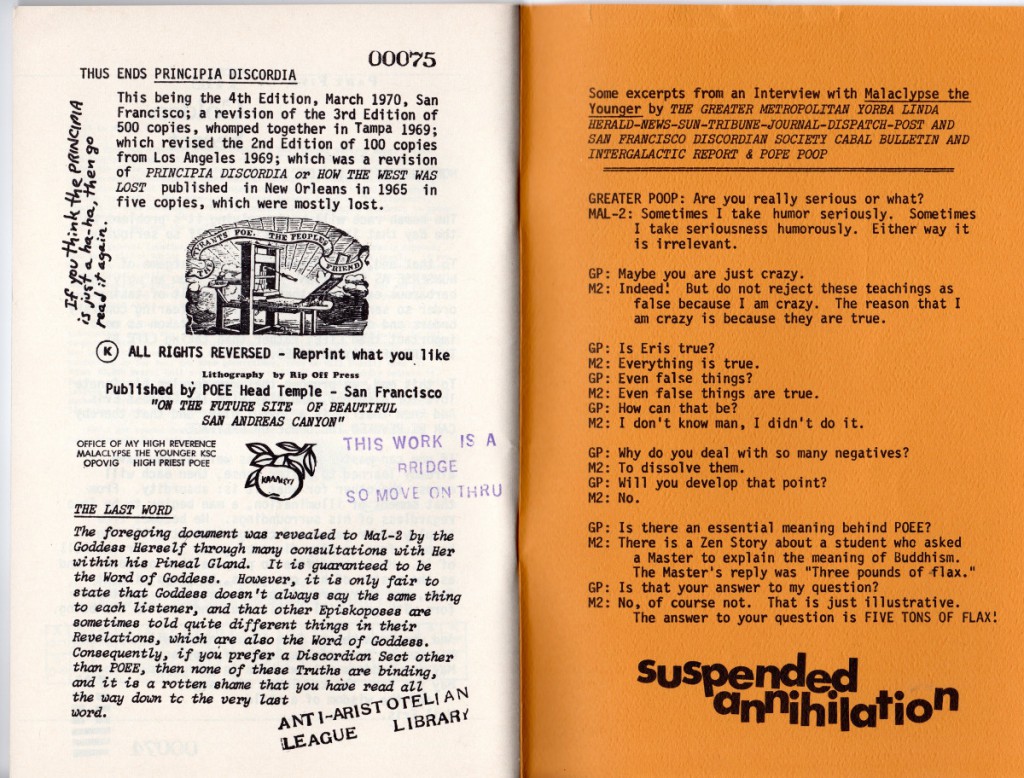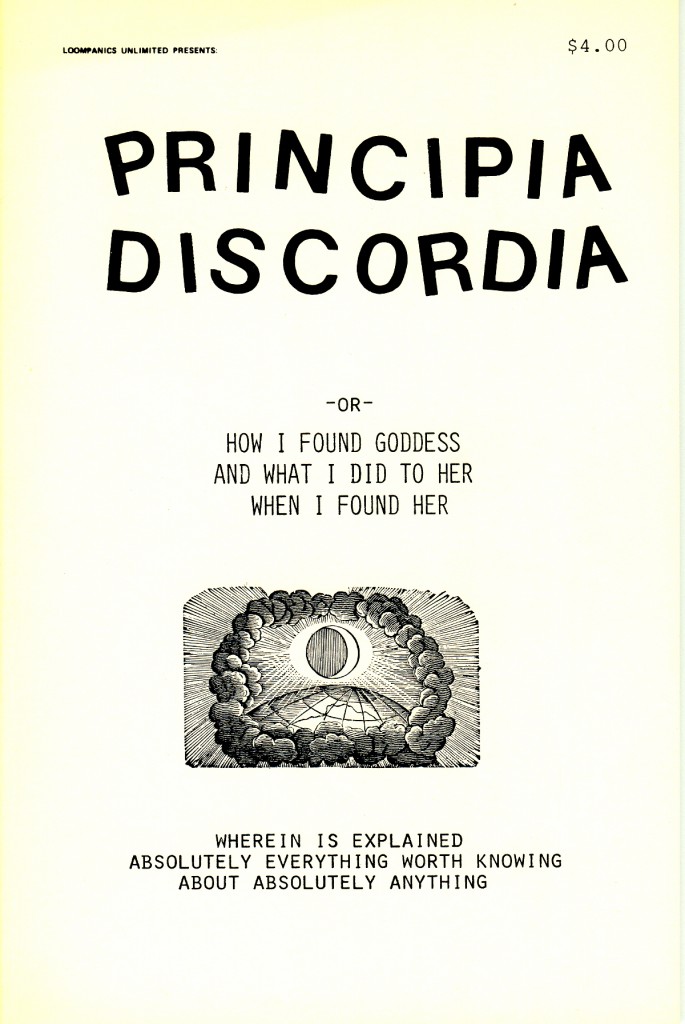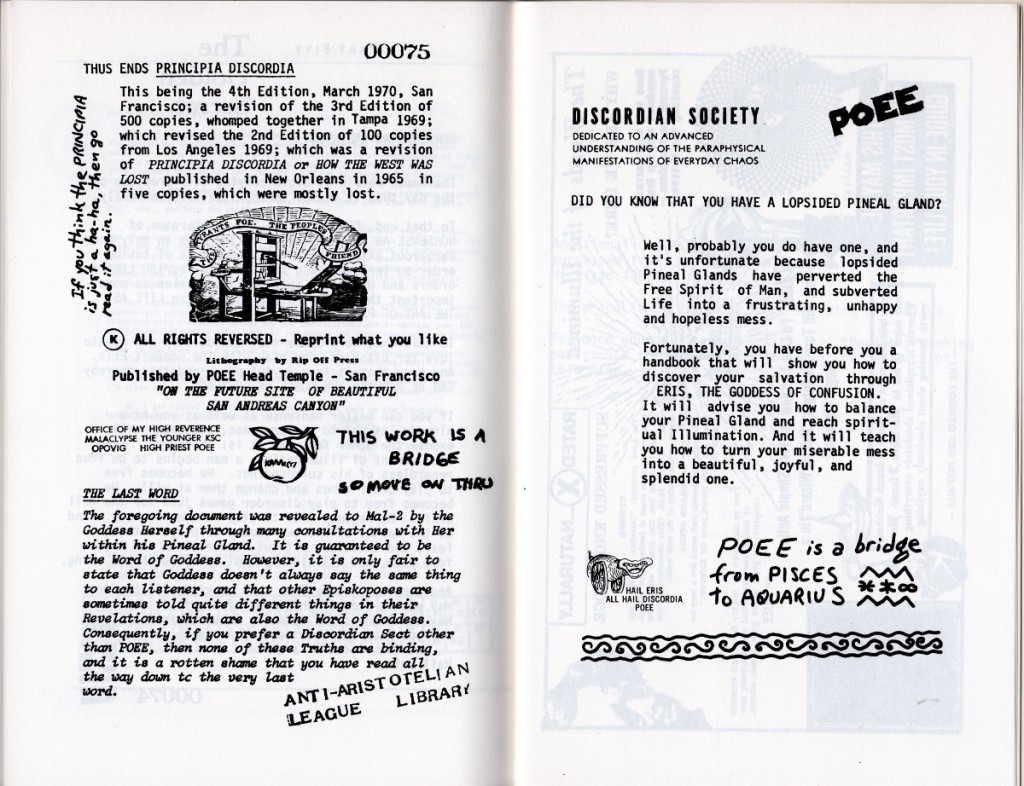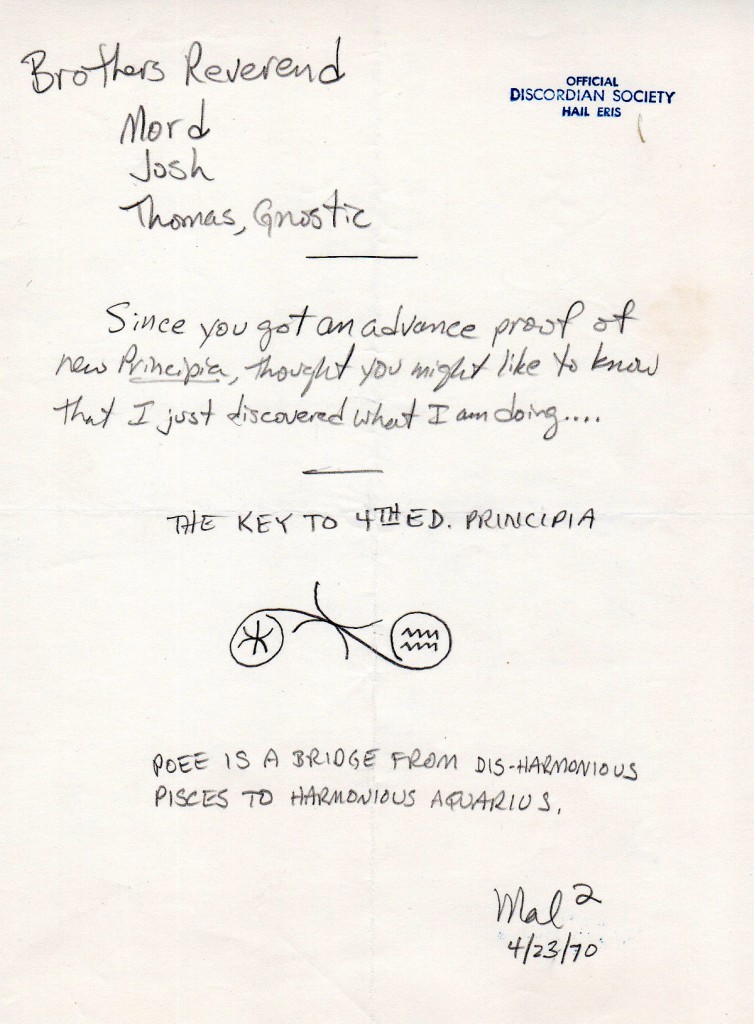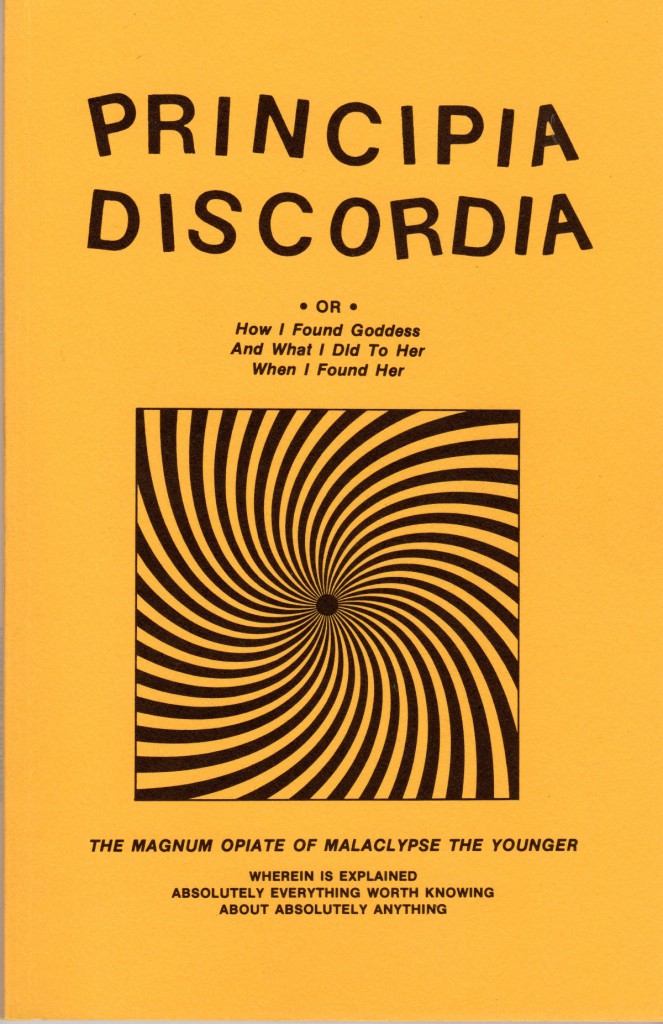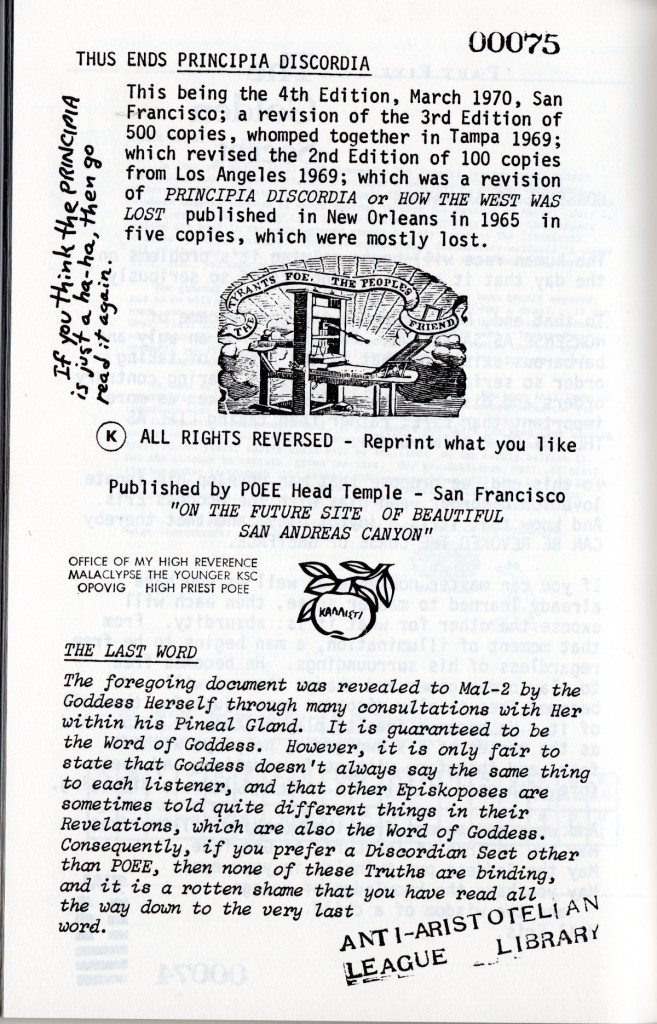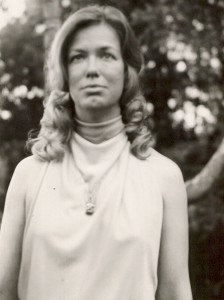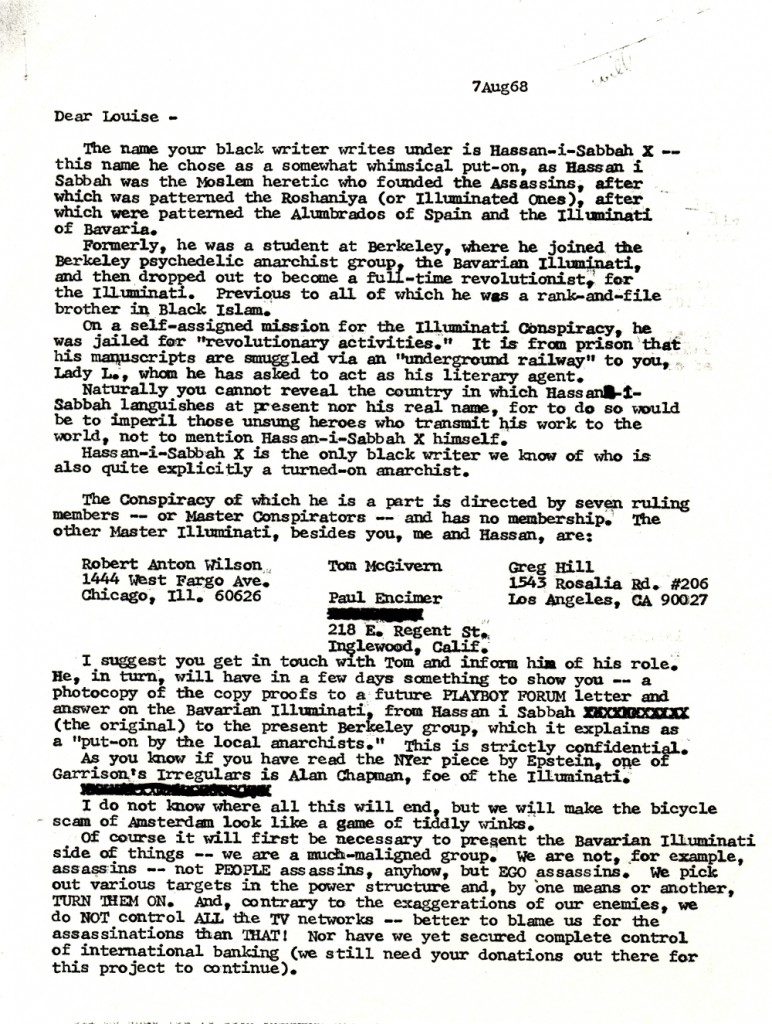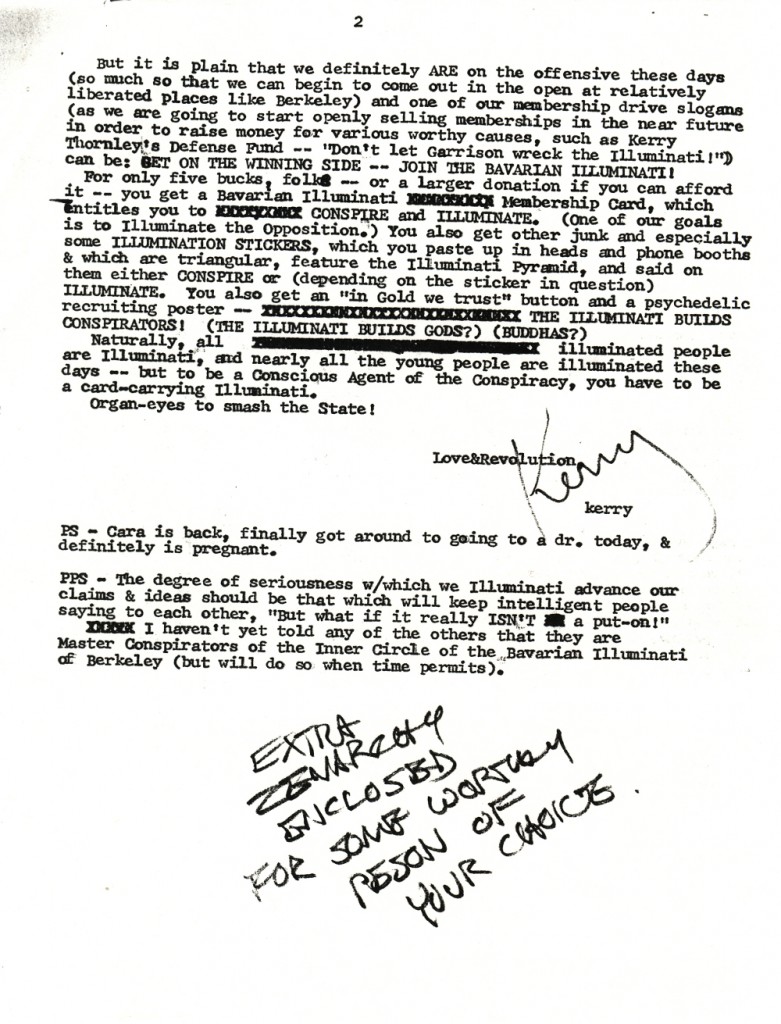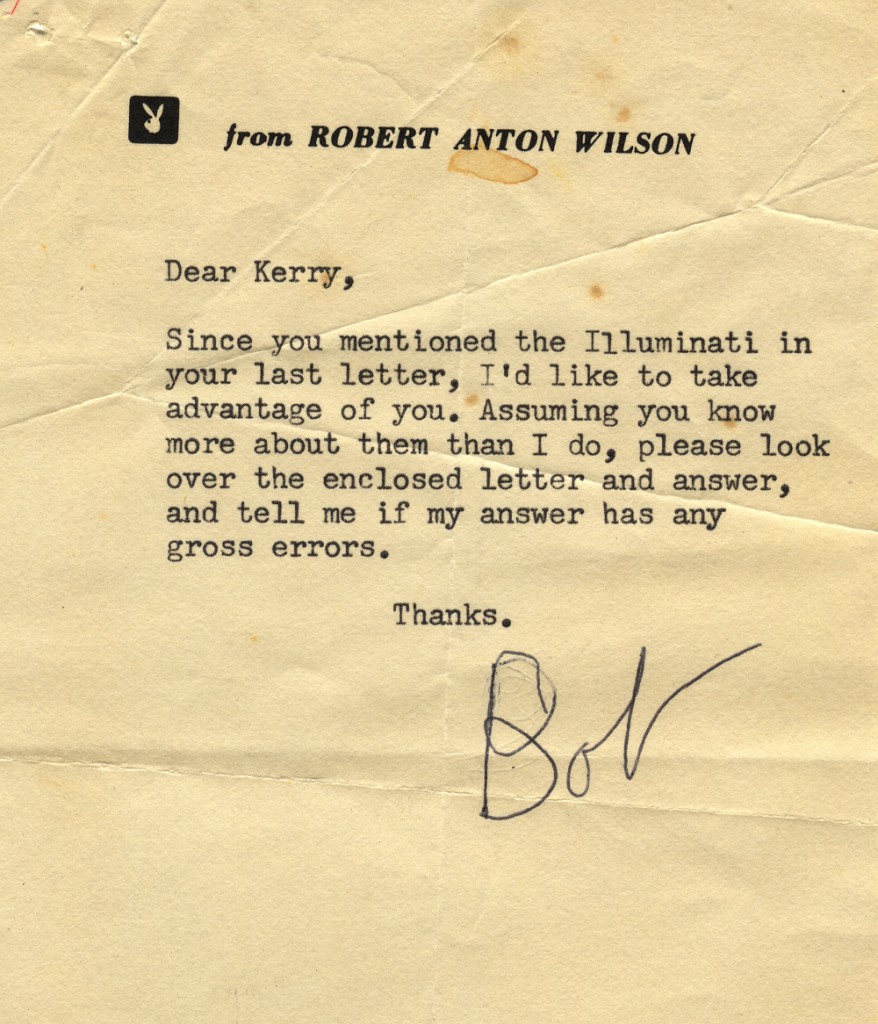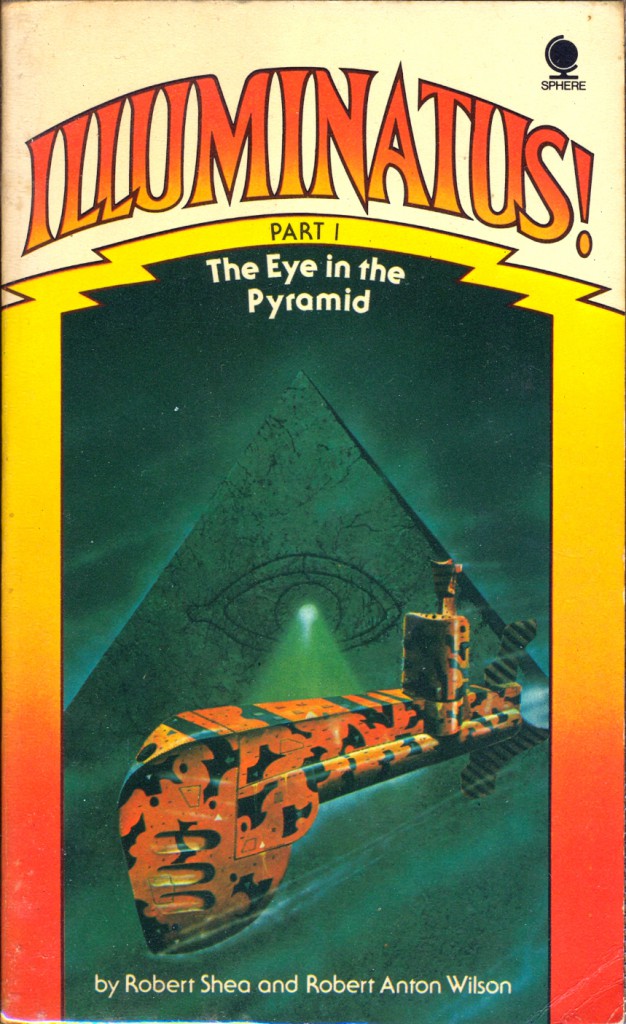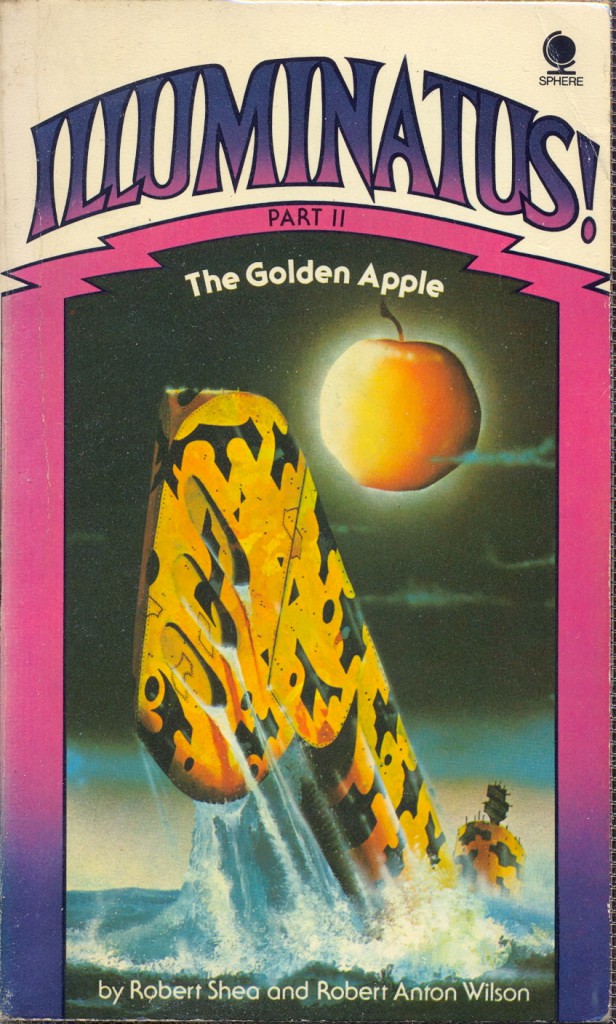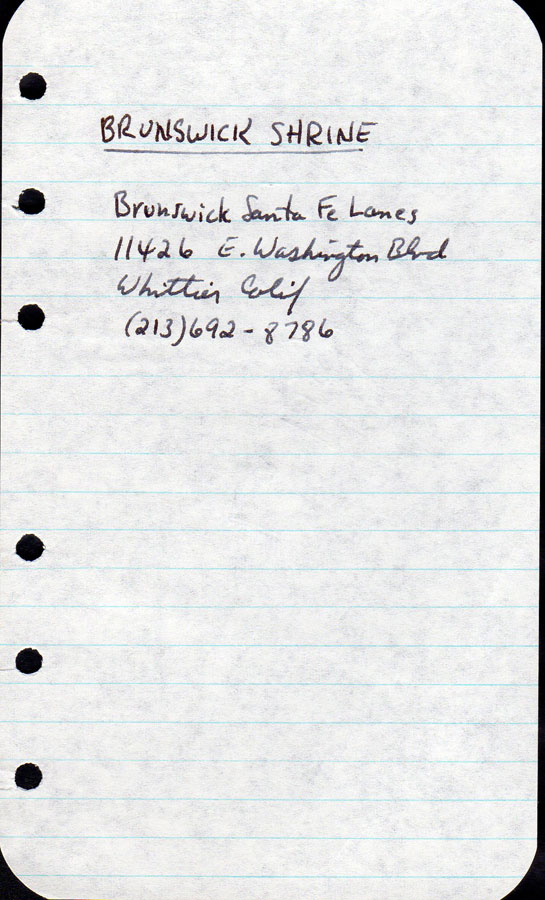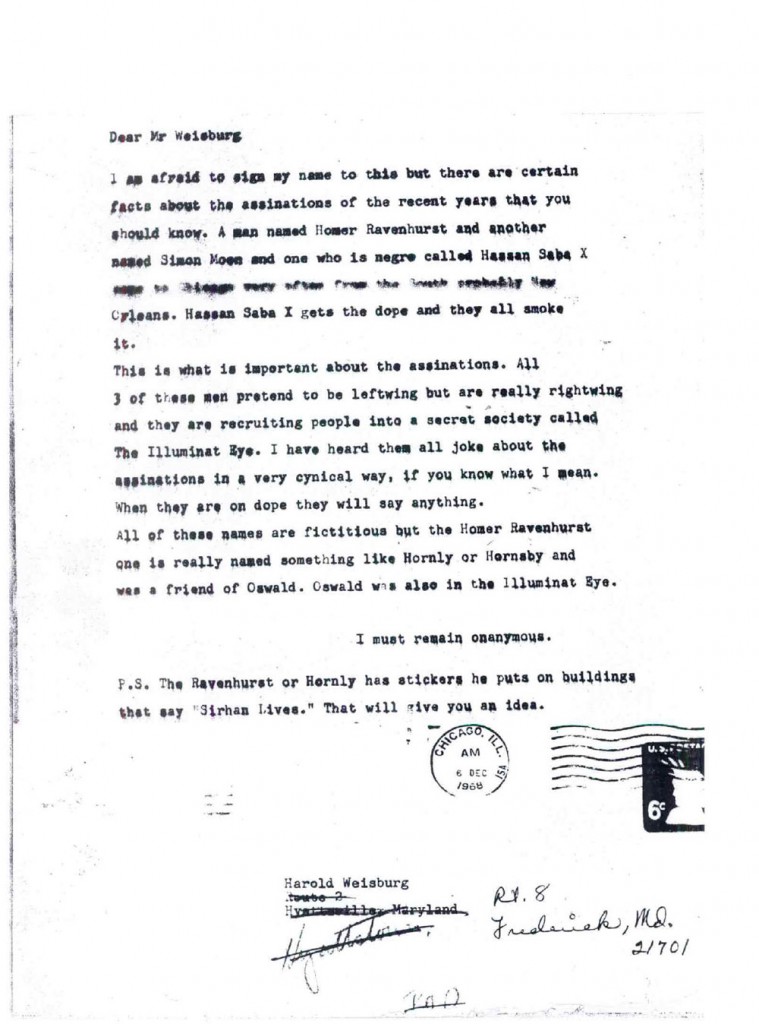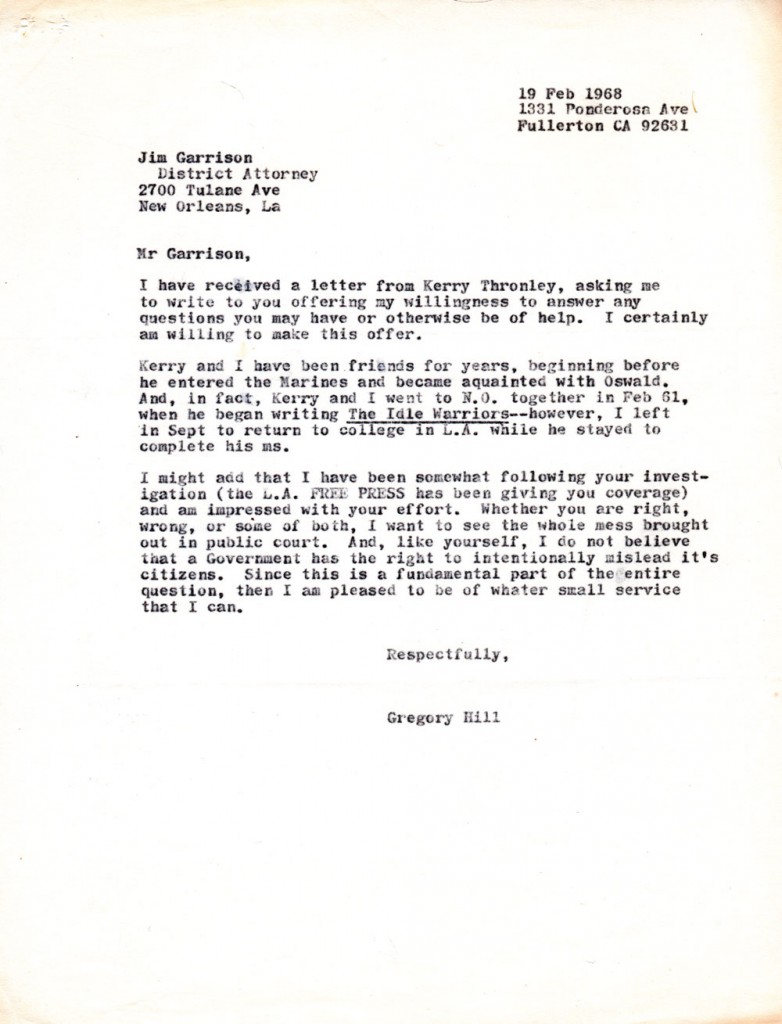
and Be Happy.
According to John F. Carr, the following list of Discordian Holidays were part of a non-fiction work entitled How to Have Fun and Be Happy that Camden Benares wrote sensing a strong need for such a work.
Unfortunately, his agent was never able to sell it.
—Adam Gorightly
Fun Friday
Fun Friday occurs four times each year. In any month that has five Fridays, the fifth Friday is Fun Friday, the symbolic anniversary of the day that Eris decided everyone should have more fun. This holiday is celebrated by doing anything that creates more fun for all.
JANUARY HOLIDAYS
1-1, Bogey’s Day
This anniversary of the birthday of Humphrey Bogart is celebrated by watching any of the 75 films in which he appeared.
1-5, Carioca Lodge Day
This is the anniversary of the founding of the Discordian Carioca Lodge in Rio de Janiero by the Portuguese Camho family and the Chinese Ho family. It is celebrated by eating Portuguese, Chinese, and Brazilian food, listening to Brazilian music, and watching Brazilian movies.
1-15, St. Afrodite’s Day
This is the day Discordians remember Aphrodite, the Greek goddess who became a Discordian saint when she transformed herself into the black beauty known as St. Afrodite. Celebrations usually include eating soul food and listening to rhythm and blues.
1-23, St. Bobcat’s Day
This is a celebration of the birthday of the son of Fred C. Dobbs and Sara Modrey, the famous Texan Discordian Robert Catman Dobbs, also known as St. Bobcat and the Dealey Lama. St. Bobcat devoted much of his life to aiding unfortunates who joined the Sub Dude cult. Discordians celebrate by saying hello to people named Bob and petting cats.
1-25, Liter Label Lark Day
The repackaging of alcoholic beverages according to the metric system was a Discordian project intended to prevent people from considering consumption of a fifth of liquor to be catma. Discordians who consume alcohol celebrate this day by having one drink. Discordians who don’t consume alcohol celebrate this day with a drink of golden apple juice.
FEBRUARY HOLIDAYS
2-2, Renew Old Acquaintances Day
Discordians celebrate this day by sending greeting cards to old acquaintances they haven’t been in touch with lately.
2-5, Dadanova Day
Dadanova is the famous Discordian art movement. The day is celebrated by creating and sharing art.
2-14, St. Heat’s Day
In remembrance of the great love that Valentine Heart and Valentina Heart had for each other, Discordians spend time having fun with those they love.
2-15, Lupercalia Transmogrified
Lupercalia is an ancient Roman holiday concerned with sex and abundance. Discordians are encouraged to develop their own rituals and ceremonies for this holiday.
2-23, Didyme’s Day
This holiday is in memory of the Dogon-Greek oracle who read tarot cards for Eris. Appropriate ceremonies are those which forecast the future or demystify the present. The following poem by Didyme Thelema’s lover, Asklepiades, is usually read aloud:
Didyme plunders me with her beauty.
When I look at her I am wax over fire.
If she’s black, what of it? So are coals.
When kindled, they glow like blooming roses.
MARCH HOLIDAYS
3-3, Pass Day
This is the day Discordians pass on the things they don’t want. Special celebrations are held in Pasadena, Pascagoula, Pashkovo, Passaic, and Passo Fundo. Some Discordians pass out free cards which read:
F R E E P A S S THIS PASS ENTITLES THE BEARER TO PASS BY ANY OPTIONAL OPPORTUNITIES AT ANY TIME. GOOD FOREVER OR UNTIL NEXT TUESDAY, WHICHEVER COMES FIRST. COURTESY OF THE DISCORDIAN SOCIETY.
3-5, Self-Esteem Day
On this day any Discordian may award herself or himself any honor, degree, or title that seems appropriate.
3-15, Turkey Vulture Day
Discordians celebrate this day by facing toward Hinckley, Ohio, where the turkey vultures roost, and by listening to Simon and Garfunkel’s recording of “El Condor Pasa.”
3-17, Rex Saxonda Film Day
Discordians celebrate by brushing the film off their teeth and watching any motion picture film. Rex believed that every film had value regardless of content.
3-19, St. Swallow’s Day
This is the time for remembrance of St. Swallow who spent years breeding swallows with homing pigeons. The faithful face Capistrano and swallow five times. There is no requirement as to what is to be swallowed. Some skeptics believe that people who celebrate this day will swallow almost anything.
APRIL HOLIDAYS
4-4, Square Day
Discordians celebrate this day by finding fun in the ordinary. Square dancing to Steve Allen’s “Very Square Dance” is encouraged. At least five minutes of television should be watched as part of the celebration.
4-5, Be Kind To Tourists Day
Discordians celebrate this day with random acts of kindness to tourists. Those who find this difficult to do can go some place out of town and pretend to be tourists.
4-15, Break Day
This is the day all Discordians recognize their value and give themselves a well deserved break.
4-29, Duke’s Day
This is Duke Ellington’s birthday, celebrated by listening to, singing along with, or dancing to the music of this American master of music.
MAY HOLIDAYS
5-1, Adam Weishaupt’s Day
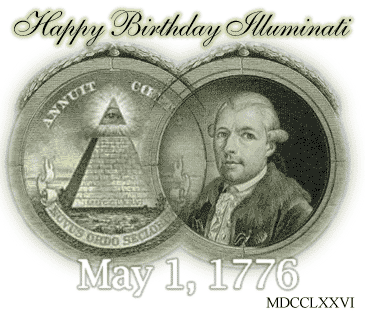 This day is the anniversary of Adam Weishaupt’s founding of the Bavarian Illuminati, rumored to be a front organization for promoting Discordianism. Discordians celebrate by eating Bavarian cake and watching traffic until five autos from the Bavarian Motor Works (BMW) pass.
This day is the anniversary of Adam Weishaupt’s founding of the Bavarian Illuminati, rumored to be a front organization for promoting Discordianism. Discordians celebrate by eating Bavarian cake and watching traffic until five autos from the Bavarian Motor Works (BMW) pass.
5-5, St Gulik’s Day
St. Harvey Gulik, Guardian of the Gentle and Protector of the Harmlessly Weird Ones, is honored on this day. St. Gulik’s familiar was the rabbit so eating a rabbit made from chocolate candy is an appropriate act. Watching the motion picture Harvey, inspired by St. Gulik, is considered an act of devotion.
5-15, Tree Day
Discordian celebrate this day by planting a tree, thinking of five apple trees, or thinking of one apple tree five times.
5-23, Buddha’s Birthday
 Although the evidence that Buddha was a Discordian is circumstantial and anecdotal, Discordians celebrate Buddha’s birthday by saying “Happy Birthday, Bud.” Discordians who are especially devout read aloud from Discordian Zen Buddhist texts such as Zen Without Zen Masters, A Handful of Zen, and Riding Buddha’s Bicycle.
Although the evidence that Buddha was a Discordian is circumstantial and anecdotal, Discordians celebrate Buddha’s birthday by saying “Happy Birthday, Bud.” Discordians who are especially devout read aloud from Discordian Zen Buddhist texts such as Zen Without Zen Masters, A Handful of Zen, and Riding Buddha’s Bicycle.
5-25, Creation Day
This is the anniversary of the Erisian creation of all chaos. Discordians celebrate this day by chanting the Discordian Taoist truth:
“Creation and creator are one; there is no creator separate from creation.”
JUNE HOLIDAYS
6-5, Golden Apple Day
This is the day when each Discordian is entitled to award herself or himself the Golden Apple Achievement Award for outstanding achievement in Discordianism.
6-6, St. Helen’s Day
This is the day that St. Helen of Troy is honored. She apologized to Eris for her unintentional part in the Trojan War and became a Discordian. When last heard from, the reincarnated Helen was working as a waitress at Ships Coffee House where it was said that she had the hips that brought a thousand tips.
6-15, Liberation Day
On this day Discordians remind themselves that their lives are much better since they considered themselves liberated.
6-23, Unknown Saints Day
Since all Discordians are considered saints according to the holy writings of Omar and Malaclypse, this day honors all the Discordians whose names are unknown.
6-25, Know Saints Day
On this day, Discordians honor the other four categories of Discordian saints: living saints, dead saints, fictional saints, and imaginary saints.
JULY HOLIDAYS
7-4, Hodge Podge Lodge Day
This is a celebration of the founding of the first American Discordian lodge by Adam Weishaupt after he fled Bavaria and came to America where he initiated George Washington and later impersonated him. Johnny Appleseed was also initiated by Adam in this lodge. The celebration consists of eating an apple while looking for Discordian symbolism on a one dollar bill.
7-5, Freedom Day
This is the day Discordians celebrate being free of the religious dogma that clogs the pathways of so many brains.
7-7, Mirror Compliment Day
On this day, Discordians look into their mirrors and compliment the mirrors on having the good taste of having such a wonderful, fun-loving owner.
7-14, St. Merde’s Day
This is the day Discordians congratulate themselves on turning the crap of their lives into fertilizer.
7-23, Jack Slack’s Day
Jack Slack is honored this day for his work in guru liberation, liberating gurus from their mistaken beliefs that they are channels for liberation.
AUGUST HOLIDAYS
8-5, St. Otis the Elevated’s Day
On this day Discordians celebrate the elevation of St. Otis by riding in an Otis elevator.
8-8, St. Pythagoras’s Day
St. Pythagoras was fascinated by the number eight. On this day Discordians do eight things that bring more fun for everyone.
8-15, Theatre Night
On this night, Discordians gather at 8:15 before any theatre that has an 8:30 curtain time and entertain those patrons standing in line until they are admitted.
8-23, Nancy Fancymanner’s Birthday
Nancy is remembered by her great contribution to Discordian style. She was the one who said, “Acquiring Discordian style is a matter of individual chaotic subtlety while being fashionable or trendy is merely a willingness to follow herd instinct.”
8-30, St. Scrivener’s Day
On this day Discordian writers are honored by other Discordians who read aloud from published works.
SEPTEMBER HOLIDAYS
9-9, Eris’s Birthday
Discordians celebrate Eris’s birthday on this date because no one is certain what the correct day is. Greek food and golden apples are usually served.
9-17, Emperor Norton’s Day
This is the anniversary of the day in 1859 that San Francisco Discordian Joshua Abraham Norton issued a proclamation declaring himself Emperor of the United States. Discordians celebrate by reading aloud the Emperor’s proclamation which is reprinted here.
PROCLAMATION
At the peremptory request of a large majority of the citizens of these United States, I, Joshua Norton, formerly of Algoa Bay, Cape of Good Hope, and now, for the past nine years and ten months of San Francisco, California declare and proclaim myself Emperor of the United States, and in virtue of the authority thereby in me vested do hereby order and direct the representatives of the different States of the Union to assemble in the Musical Hall of this city on the first day of February next, then and there to make such alterations in the existing laws of the Union as may ameliorate the evils under which the country is laboring, and thereby cause confidence to exist, both at home and abroad in our stability and integrity.
Norton I, Emperor of the United States
9-23, Dog Star Day
On this day, Discordians celebrate the existence of Sirius, the Dog Star, legendary home of the Nommos, space travelers who visited this planet before the Trojan War. This holiday may be celebrated in five ways:
- Eating a hot dog
- Looking at a dogwood tree
- Singing any song with dog in the lyrics
- Petting a dog
- Telling shaggy dog stories
9-25, Erotic Terrorism Prevention Day
This day marks the founding of the Erotic Terrorism Protection League by Felix Pendragon. Erotic terrorism is defined as activity related to sex for the purpose of scaring one or more bystanders or observers. On this day Discordians expand their knowledge of sex to protect themselves from erotic terrorism. One method is to read the following poem by Felix Pendragon:
THE ABC’S OF EROTIC
TERRORISM PROTECTIONAutoeroticism is sex for one.
Brothels charge money for all sexual fun.
Condoms for safe sex are a must.
Dirty pictures show people in lust.
Exhibitionism is showing it all.
Fetishism is weirdness having a ball.
Genital identification is hard to fake.
Hedonism is sex for pleasure’s sake.
Inhibition is what you can lose.
Jailbait is someone too young to choose.
Kinky people to strange sex aspire.
Libido is a name for sexual desire.
Masturbation remains the safest sex play.
Narcissists love themselves in every way.
Obscenity is in the mind of the beholder.
Puberty comes as a child grows older.
Quckie is sex done in a hurry.
Randy is horny to the point of worry.
Satyr is a male who can’t say no.
Tart is a female ready to go.
Uprighters have sex while they stand.
Voyeurs think sex watching is grand.
Yodeling is much more oral than not.
Zoophiles find animals make them hot.
9-30, Kokomo Dragonland’s Day
This day honors Kokomo Dragonlady, the Indian from Indiana, who promotes the safest sex through her mail order organization, Sex Without Partners. Kokomo claims to be a spiritual and perhaps a physical descendent of Johnny Appleseed. She requests that on this day Discordians plant their seeds in her name.
OCTOBER HOLIDAYS
10-5, Inexpensive Gift Day
On this day devout Discordians show self-appreciation by giving themselves an inexpensive gift.
10-10, Hildegarde’s Night
Bewitching Hildegarde was famous for her on-campus tricks, usually performed at night. Discordians tell stories of the sexual escapades of Hildegarde who was famous on ten campuses and captured the heart of Georgia Tech’s most famous student, George P. Burdette.
10-23, Hugo Troy Tutlege, Jr.’s Birthday
Gift’s are optional on this day because Hugo is the richest Discordian in the world. He is honored for financing the liquor liter label lark, the Discordian Street Theater Extravaganza, the Discordian Players Group Spectacular, and the Weird Oral History Organization (WOHO). In person, Hugo is elusive and a bit of a loner. There is no record of him ever having been seen by two people at the same time. The most common thing said about Hugo is, “Hugo was here. He just left.” This day may not be Hugo’s actual birthday but is derived from his favorite verse of his favorite song, “Chisholm Trail,” namely:
I started up the trail October twenty third
And I throwed my rope in a big cow turd.
Come a ti yi youpy, youpy yea, youpy yea
Come a ti yi youpy, youpy yea.
10-31, Discordian Saints Day
Most Discordians use the day to honor their favorite Discordian saints, including themselves.
NOVEMBER HOLIDAYS
11-5, Motion Picture Day
This is the day that Discordians look for both obvious and subtle references to Discordianism in any film they watch.
11-11, St. Yossarian’s Day
Since eleven plus eleven equals twenty two, Yossarian, the military navigator in the book Catch-22 and the film of the same title is honored on this day. When Yossarian realized that war was crazy and that being in a war was driving him insane he became the Discordian Saint of Military Intelligence. Discordians remind themselves on this day that any civilian outranks all military personnel.
11-23, Romance Day
Discordians on this day think romantic thoughts and recall the famous romantic marriage of Zelda Harrington and Felix Pendragon.
11-25, Literary Saints Day
On this day Discordians read aloud incidents of Discordian Saints in fiction and in other works containing fiction disguised as nonfiction.
11-30, Early Lunch Day
This is the day that Discordians eat lunch at 11:30 a.m.
DECEMBER HOLIDAYS
12-1, Rosetta Stone’s Birthday
This is the day Discordians remember St. Rosetta Stone by looking at stones in a rose garden.
12-7, Buddy Darma’s Day
On this day Discordians sing “My Buddy” and look for catma in weird publications.
12-23, Dragon Clan Anniversary Evening
On this evening Discordians recall and celebrate the Dragon Clan’s victory over erotic terrorism forces. Achievements are exaggerated and some lies are told.
12-25, Jay See Fitzdragon’s Birthday
The ideal celebration for this holiday is listening to bootleg recordings of the first Discordian rock band, Jay See and the Disciples of Eris. The rarity of these recordings causes most Discordians to celebrate in some other manner befitting the occasion.

